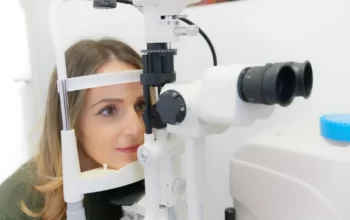
Dry eyes can occasionally accompany severe headaches. The symptoms may present all at once or gradually over time. Do headaches result from dry eyes, though?
Your head and your eyes may be affected by environmental and lifestyle factors. Let’s investigate the symptoms of dry eye disease and how they relate to headaches and migraines. Your optometrist can evaluate your vision and offer solutions for dry eye therapy during routine eye exams so that your symptoms can be relieved.
What Is Dry Eye?
Dry Eye disease occurs when there is an issue with your tear film. The fluid layer that covers the surface of your eye is called the tear film. It consists of three layers which each serves an important purpose in keeping your eyes healthy:
- An oily layer produced in your meibomian glands
- A watery (aqueous) layer produced in your lacrimal glands
- A mucous layer made in the conjunctiva of your eye
Any one of these layers may be problematic, leading to dry eyes.
The Types Of Dry Eye
There are two types of dry eye that can harm your eyes.
Evaporative Dry Eye
Evaporative dry eye is the most common form of dry eye. The absence of the oil layer in your tears causes an evaporative dry eye. Your eyes may become dry if your tears aren’t sufficiently lubricated and evaporate too quickly.
Aqueous Tear Deficiency
The other common type of dry eye disease is aqueous deficient dry eye. This kind of dry eye happens when your tears don’t have the proper aqueous layer. If this occurs, your eyes won’t be able to produce enough tears to keep them moist.
Symptoms Of Dry Eyes
Some symptoms of dry eyes include:
- pain or burning in the eye
- pressure in the eye
- a sensation that there is something stuck in the eye
- frequent blinking
- tearing up
- sensitivity to light
- blurry vision
- eye fatigue
People who experience headaches may notice that they start before they experience dry eyes, at the same time as they do, or after a period of dry eyes.
Symptoms related to the eyes and vision can also result from headaches, which typically cause head pain.
For example, migraine headaches may cause sensitivity to light or unusual visual sensations. Also, cluster headaches can cause a stabbing sensation behind one eye.

Do Headaches Result From Dry Eyes?
Dry eyes and migraine headaches have been linked in several studies.
For example, a 2017 study of 14,329 adults found that 14.4% of people who experienced migraine headaches reported a dry eye diagnosis, compared with 8.2% who did not experience migraine headaches.
Additionally, compared to 15, 22% of the study participants who had migraines also experienced symptoms of dry eyes.1% who had no history of migraine headaches.
A 2019 population study that included 72,969 participants found a similar connection. In that study, the proportion of migraine sufferers was 1.42 times more likely to have a diagnosis of dry eye disease than those who did not.
A causal link between migraine headaches and dry eyes has not yet been discovered, though. As a result, it is difficult to determine whether migraines result in dry eyes, whether dry eyes cause migraines, or whether another factor accounts for the connection.
Various factors can act as triggers for migraine attacks in sufferers. A trigger for some people may be eye strain or dry eyes.
Another possibility is that the two complaints have similar triggers. For example, neck pain and exposure to light are common triggers for migraine headaches. Long periods of time using computers or other screens may also trigger dry eyes.
Some other potential links between dry eyes and headaches include:
- Cluster headaches: The severe headaches known as cluster headaches typically only affect one side of the head. Some people report feeling pain or a stabbing sensation in or near the eye. They might mistake this for dry eyes or think that dry eyes are to blame for the discomfort.
- Sjörgen’s disease: Sjörgen’s is an autoimmune condition, which means that it causes the immune system to attack healthy tissue. Dry eyes may result from difficulties with tear production. Additionally, it might result in headaches, joint pain, and tension.
- Eye strain: The eyes may feel dry or worn out due to eye strain. Some might blame dry eyes for this. In addition to headaches and other types of muscle tension, such as neck pain, people with eye strain may also experience these symptoms, particularly if they spend a lot of time sitting still and staring at a computer.
How Do Headaches And Dry Eyes Relate To One Another?
Even though the link between headaches and dry eye disease has not yet been established, it is possible that it is the cause of the condition. According to studies, having a migraine diagnosis doubles your likelihood of experiencing dry eye symptoms by about 20%. When migraines are present, the signs of dry eye may become more obvious.
A person who is prone to migraines may experience negative effects from their eyes’ abnormal structural characteristics. But symptoms brought on by other things can be seen in the eyes and the head as well. Some drugs can cause migraine and dry eye symptoms.
Increased light sensitivity can occur in migraineurs. However, there are some treatments that can help manage dry eye and lessen the symptoms that go along with it.
What Causes Dry Eyes?
Dry eyes can result from anything that obstructs your tear ducts. Your eyes may appear bloodshot and may feel scratchy or uncomfortable due to a lack of moisture.
Dry eyes can be caused by several environmental factors, including:
- low moisture in the air
- high temperatures
- sun
- pollutants, including natural pollutants such as pollen and other allergens
- excessive time in front of a computer screen
One medical condition that can cause dry eye is Sjögren’s syndrome. An autoimmune disease causes this syndrome. This indicates that something inside your body is perceived as foreign by your immune system, which causes it to attack it. Dry mouth and dry eyes are typical signs of this syndrome.
Make an appointment with your doctor if you frequently experience dry eyes. They could contribute to figuring out the root of the problem. Additionally, you should see your doctor if you frequently have dry eyes and a headache. This could indicate an underlying medical condition.
How To Treat Dry Eyes?
Depending on your symptoms, a medical dry eye treatment plan may begin with specific recommendations for modifying your surroundings. This might entail removing allergens from your home or getting a humidifier. Artificial tears might also be suggested by your doctor.
Contrary to the majority of over-the-counter (OTC) formulations, your doctor might recommend artificial tears for more severe cases that don’t contain preservatives. For instance, the prescription eye drop cyclosporine (Restasis) reduces inflammation, which can result in dry eyes. While topical steroids may offer relief, they shouldn’t be used over the long term.
Dry eye can also be treated with medicated contact lenses or glasses that block out irritants. As a last resort, your doctor might also suggest having surgery to treat your symptoms.
Prevention Of Dry Eyes
By keeping a journal of one’s triggers and then removing or avoiding those triggers, it may be possible to avoid headaches and dry eyes.
For example, a person might find that dehydration and eye strain trigger both headaches and dry eyes.
To prevent headaches, a person can also try:
- asking a doctor about headache prevention medication if they have chronic migraine headaches or other severe headaches
- exercising regularly, may improve general headache symptoms and reduce the pain of tension headaches
- taking frequent stretching breaks when working in an awkward position or in front of a computer
- developing strategies for managing stress
To prevent dry eyes, a person can also try:
- taking frequent breaks when working and blinking regularly when staring at a screen
- using a humidifier to make the air less dry
- asking a doctor about a fatty acid supplement
- drinking plenty of water
- minimizing time spent in very dry environments
- not allowing air to blow into the eyes, such as by not sitting in front of a fan or heater
Conclusion
It takes time to lessen headaches and dry eyes. Although dry eyes do not cause headaches, it is common to experience both at the same time. Some of the discomfort caused by migraine or headache symptoms may be reduced by treating dry eye disease. It’s best to schedule an appointment with our optometrists if your eyes frequently feel dry and uncomfortable. One strategy for managing migraines and headaches is to make sure you can see clearly and comfortably.



